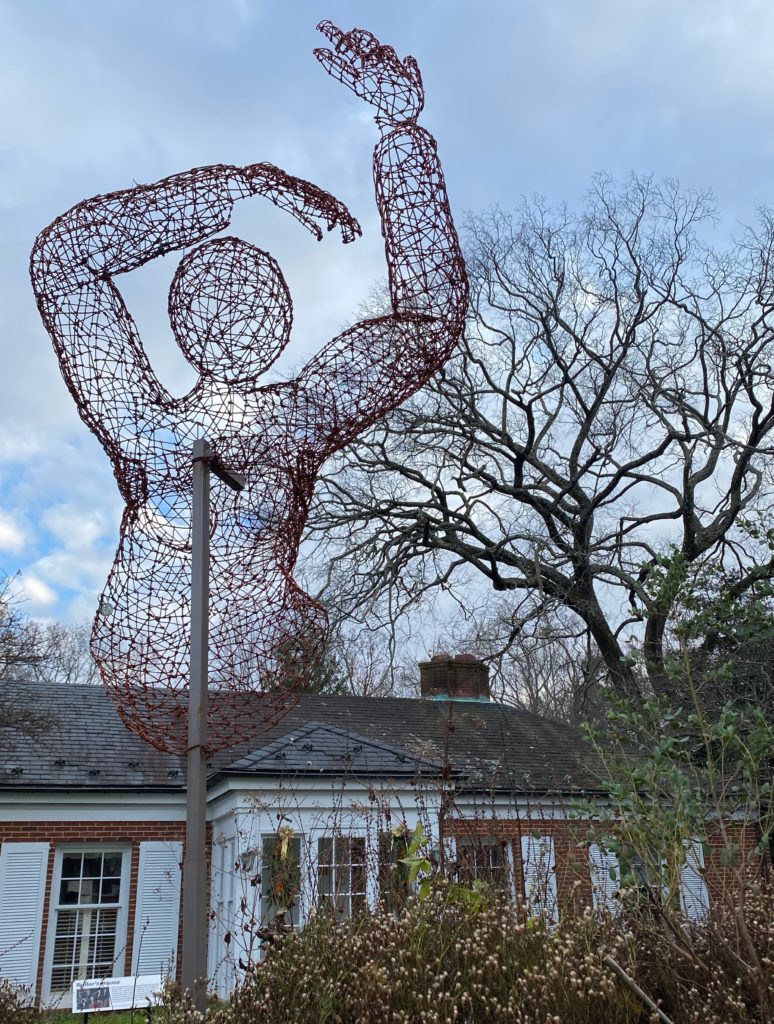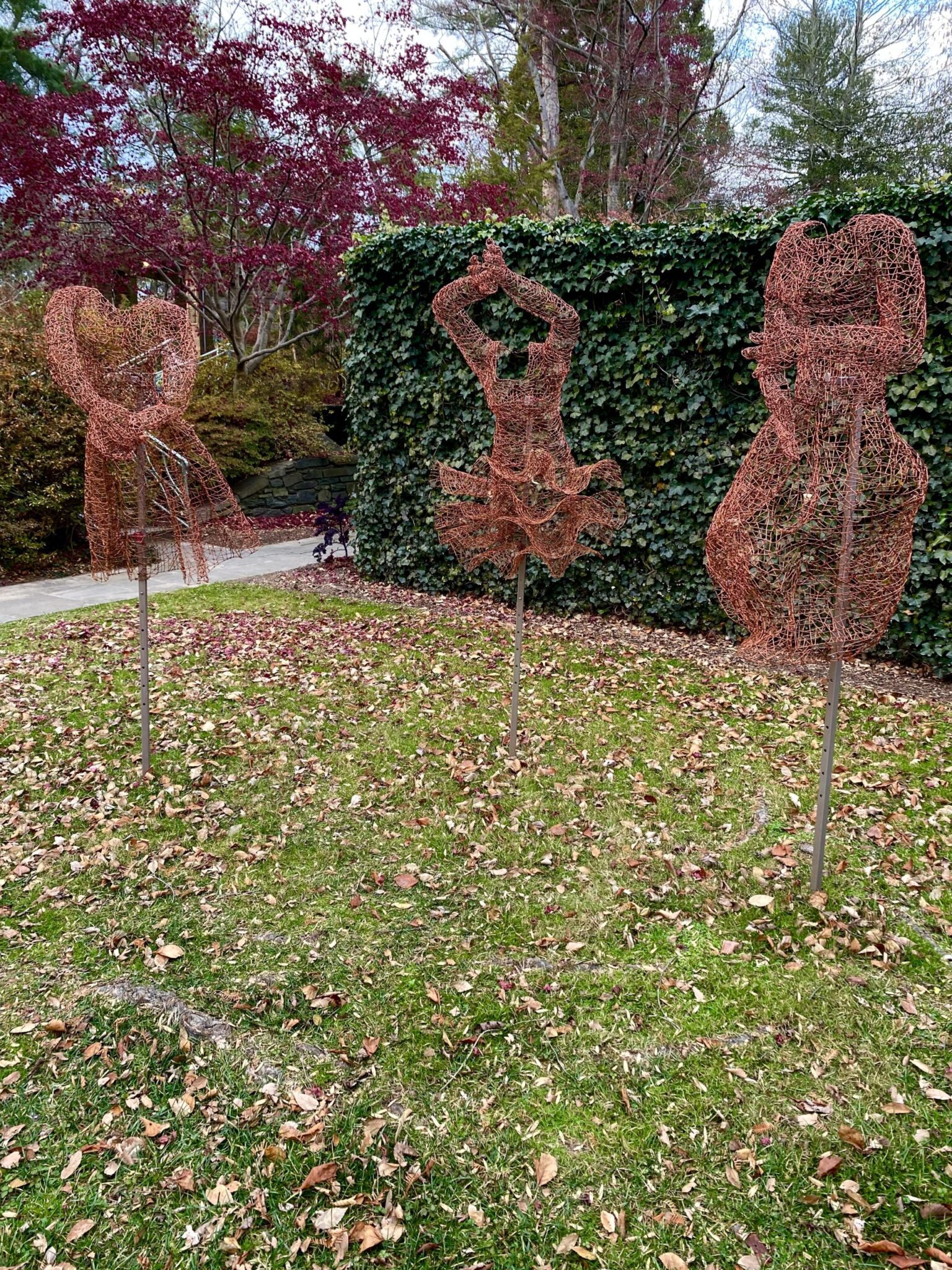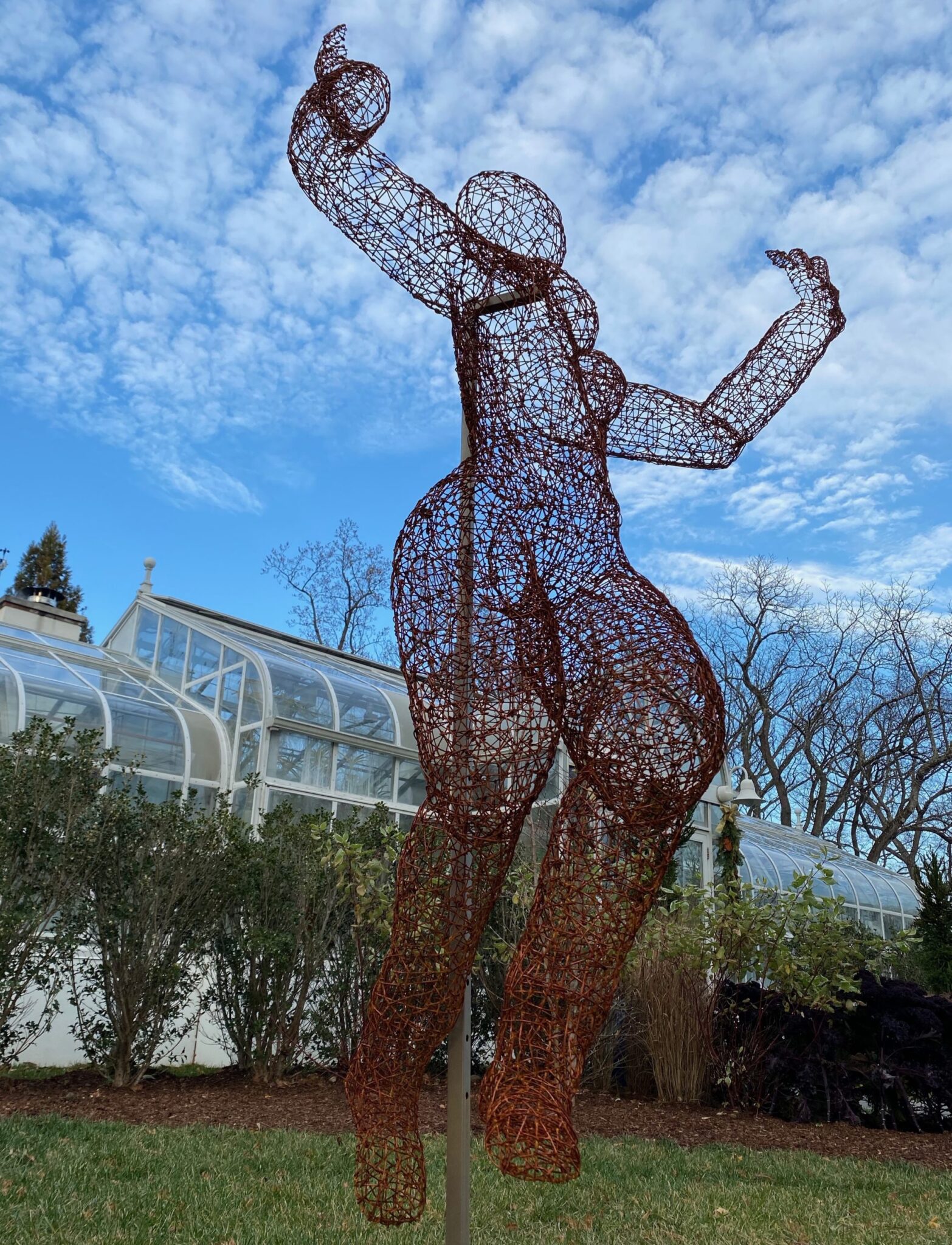‘Rich Soil’: A Must-See at Hillwood Gardens
By • December 30, 2021 One Comment 1685

Looking for a splendid and thought-provoking outdoor sculpture walk in the nation’s capital during these cabin fever times?
Through Jan. 9, the Hillwood Estate, Museum and Gardens’ “Rich Soil” exhibit in the lush gardens of the 25-acre historic estate at 4155 Linnean Ave. NW once owned by Marjorie Merriweather Post (1887-1973) is a must-see for its provocative, haunting beauty, ghostly elegance and the force of its historical critique.
Created by contemporary artist Kristine Mays, “Rich Soil” features “life-size, three-dimensional dancing wire sculptures” emerging throughout the estate’s captivating gardens. Mays “breathes life into wire, transforming an industrial product into fascinating and moving works of art,” according to Hillwood’s description of the art installations – only the second such installation in the gardens’ history.
“Springing to life throughout the 13 acres of formal gardens, [Mays’s] 29 sculptures will surprise visitors as [the sculptures] dance throughout the garden beds, bursting forth from the plant life,” according to Hillwood. The “enchanting formal gardens” of the estate designed at Post’s behest by prominent landscape architects Umberto Innocenti and Richard Webel in the 1950s include “a Japanese-style garden, a rose garden, a French parterre, and a greenhouse full of exotic orchids” with blooms throughout the winter.
In “Rich Soil,” Mays, an African American sculptural artist and devoted “maker” from San Francisco, seeks to pay “honor to the ancestors – those that walked, lived on, and tended to this land – to the lives that have been recognized and those that have been forgotten.”

In “Rich Soil,” Mays’s figures evoke forgotten laborers who toiled the land or tended the manor houses in the area. Photo by Chris Jones.
The human-figured rusted wire sculptures in supple postures of dance inspired by Alvin Ailey’s composition “Revelation,” are intended to “deliver a message of strength while challenging how we view ourselves and others,” according to Hillwood. “Though they look fragile and soft, they are solid and strong. Within the confines of hard metal wire is a sense of resilience and perseverance – a need to push forward and thrive. The work also speaks to identity – the question of who we are and what we can do with our lives, the impact our lives have on the world.”
As the curators of the Hillwood Museum, Estate and Gardens have sought to examine the historic role of labor and its racial dimensions in the estate’s history, the “Rich Soil” exhibit – Mays’s first ever outdoor show, originally displayed at Filoli Historic House and Garden in San Francisco – was deemed ideal to bring to Hillwood. Marjorie Post – at one time the wealthiest woman in the United States and owner of General Foods — was not only famously devoted to dance education but Mays’s elegant, resilient and strong figures help to commemorate the forgotten workers on the land in the area.
Historical research conducted by Hillwood Museum indicates that while enslaved laborers were employed at nearby Peirce Mill prior to the Civil War, the Hillwood estate itself employed only free labor since it was built in the 1920s. Nevertheless, the sculptural installations appear to rise and dance as ghostly apparitions against backdrops of the estate’s colorful showcases of wealth and prestige as if to implicate the harsh treatment of exploited, forgotten laborers who toiled on the plantations and in the manor houses of the surrounding countryside.

Photo by Chris Jones.
What makes “Rich Soil” such an exciting show to bring to Washington? “‘Rich Soil’ is a display of sculptures recognizing the unknown, the unnamed,” observed Dr. Rebecca Tilles, associate curator of Hillwood in the video introducing the exhibition. “From the native peoples on whose ancestral lands we’re standing to the people who were enslaved at nearby Peirce Mill,” Tilles said, “Rich Soil has encouraged and inspired us to dig deeper into the history of the land at Hillwood… “Rich Soil” is not only a beautiful visual experience but also a powerful reminder that art can inspire change.”
The Georgetowner spoke with Tilles to ask about how it feels to bring “Rich Soil” to Hillwood. “I am particularly thrilled to showcase Kristine’s work at Hillwood and to have collaborated with such a talented artist,” Tilles said. “I’m excited by how Kristine’s work not only aesthetically connects to Hillwood’s gardens, offering new perspectives and shapes, but how the multiple levels of meaning to her work relate to the history of Hillwood’s land, including Marjorie Post’s passion for and patronage of dance and the honoring and recognition of the ancestors and those who tended the land that have been forgotten. Just as the figures appear to spring to life from the ground, they provide hope for renewal and perseverance for us all.”
For Tilles, Mays’s technical skills in sculpture also make the show a must-see. “Kristine’s sculptural work is incredibly creative and impressive, both physically and conceptually. The way she single-handedly transforms thousands of pieces of industrial steel wire by hand (without using molds or forms) into light and ethereal figures, expressing the human form as if in motion, is fascinating,” she said. Mays “takes inspiration from both fashion magazines and observing people’s movements and brings them to life by weaving sections of wire together like a quilt. Kristine hopes that by creating the shell, the audience will fill in the middle with different personal experiences, memories, and backgrounds. It is through her work that we can connect to a deeper purpose and spirit of our lives.”
When visiting the exhibit, Tilles recommends starting at the second floor of the Visitor’s Center to read the introductory text panel for the show, learn more about Kristine Mays and her themes, and watch the brief video provided with an interview of the artist. Once in the gardens, Tilles recommends following “the circuit beginning with the motor court, greenhouse, and cutting garden on the front side of the estate, followed by the four groupings behind the mansion.” Each sculptural grouping also has poetic texts from Mays. While in front of “Ancestral Spin” overlooking the Vista Lawn, Tilles recommends “walking downstairs to interact with the sculptures and absorb the sounds of the nearby Japanese-style garden.”
“To see “Rich Soil” here at Hillwood is an experience I could not have daydreamed about or anticipated,” Mays says in the introductory video for the exhibition. “It’s a discovery for me as well as everyone who’s seeing it for the first time. I think that’s the part that makes me giddy about it. I hope that lots of people who have never been here before come and view Hillwood. My hope is that they actually get a chance to not only see the work but to feel and experience it and that it would leave a lasting impression.”
“Rich Soil” will be on display at Hillwood Estate, Museum and Gardens through Jan. 9.


My Oak Hill Garden Club visited on a day trip last October. Such a beautiful restful spot in the Cutting Garden and educational exhibits!! My first visit, but definitely not my last!!